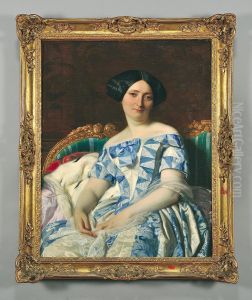A. Cavanel Paintings
Alexandre Cabanel was a prominent French painter born on September 28, 1823, in Montpellier, France. His works are quintessential examples of the 19th-century academic art tradition, characterized by its rigorous formality, classical themes, and polished execution. Cabanel was a key figure in the French academic system, a respected teacher, and a favored painter of the Emperor Napoleon III, contributing significantly to the art culture of his time.
Cabanel showed an early aptitude for art, which led him to Paris, where he entered the École des Beaux-Arts at the young age of 17. He studied under François-Édouard Picot, a noted academic painter. In 1845, Cabanel won the prestigious Prix de Rome with his painting 'The Death of Moses,' which allowed him to study in Rome at the Villa Medici, further honing his classical style and thematic preferences.
Throughout his career, Cabanel was celebrated for his figure paintings, particularly those depicting scenes from mythology and allegory. One of his most famous works, 'The Birth of Venus' (1863), epitomizes the idealized beauty and sensuality characteristic of academic art. This painting, showing Venus lying on the sea, was highly praised by the Paris Salon and bought by Napoleon III himself.
Cabanel's influence extended beyond his artwork through his long tenure as a professor at the École des Beaux-Arts, starting in 1864. He taught numerous students who would go on to become significant artists in their own right, including Fernand Khnopff and Émile Munier. His role in the academic art world was further solidified by his membership and eventual leadership in various artistic societies, including the French Académie des Beaux-Arts.
Despite the rise of Impressionism and other modern movements that challenged the principles of academic art, Cabanel remained a staunch defender of traditionalism. His works continued to be highly sought after by collectors and the French government alike. Alexandre Cabanel passed away on January 23, 1889, in Paris, leaving behind a legacy that encapsulated the height of academic painting. His art remains a testament to the technical mastery and classical ideals that defined French academic art in the 19th century.
